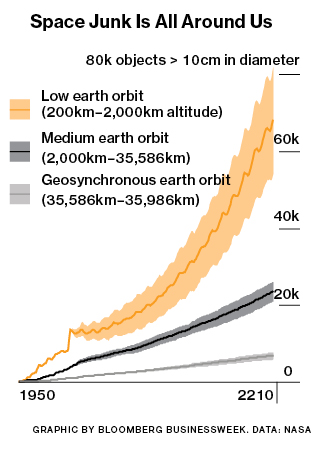Cleaning Up the Final Frontier
< < Go Back
If the world needed a reminder of the sheer amount of stuff swirling around the planet, it received a spectacular one in mid-November. The European Space Agency’s 1.2-ton GOCE satellite, which had studied the earth’s gravitational field, ran out of fuel in low orbit, reentered the earth’s atmosphere, burned up into a fiery mess, and dumped debris across the southern Atlantic just south of the Falkland Islands. The Inter-Agency Space Debris Coordination Committee—a global space agency consortium that tracks “space junk”—activated surveillance facilities around the world to monitor the destruction of the bird.
Since the Soviets kicked off the Space Age by launching Sputnik 1 in 1957, mankind has sent more than 7,100 spacecraft of some sort aloft. Along the way, an expanding miasma of refuse—malfunctioning satellites, rocket motor effluents, metal fragments, equipment lost on space walks, and even tiny flecks of paint—has spread in orbit. Computer simulations by NASA portray what looks like a cloud of fruit flies swarming around an apple—only these fruit flies travel at 17,000 miles per hour. And at that speed even a particle can do serious damage to satellites or spacecraft—a scenario dramatized in Alfonso Cuarón’s sci-fi thriller Gravity.
The space refuse problem is most troublesome in low orbits of about 500 miles above the earth’s surface. There are 21,000 pieces of wreckage the size of grapefruit or bigger—and that number grows to 500,000 if you include fragments the size of BB pellets and dust specks, according to NASA data. Some of this detritus is burned off during reentry to earth. But depending on the trajectory, other pieces can stay in orbit for decades, even centuries.
Even so, engineers disagree about how urgent the risk really is—and whether governments should spend billions on solutions that are years away from being ready. That’s practical, but maybe not the noblest way to look at the problem.
Coming to an international agreement about global warming has been tough enough. It’s hard to imagine a power like Russia or China signing off on a plan by U.S. or European space agencies to operate the kind of orbiting trash collectors backed by some scientists and companies interested in government contracts.
There are three broad and evolving strategies to cope with space debris. One solution starts at blastoff: There’s been progress by commercial companies and space agencies to adopt smarter launch and design standards (limiting the use of explosive bolts, for example, normally used to separate rocket stages) to reduce the amount of space debris entering low earth orbits.
Governments are also investing in systems that can locate the junk. Raytheon (RTN) and Lockheed Martin (LMT) are in the hunt for a multibillion-dollar U.S. Air Force contract expected to be announced later this year that will fund a massive radar system to track stuff. Known as the space fence, it will be based in the Pacific or Australia.
In November the U.S. and Australia signed an agreement to move an advanced Space Surveillance Telescope developed by the Defense Advanced Research Projects Agency from its current mountaintop position in New Mexico to Australia to better find debris in the higher geosynchronous orbits about 22,000 miles above the earth’s surface.
Other more far-out ideas include the creation of solar-powered space nets and sails to collect and redirect space junk. In 2018 the Swiss Space Center at École Polytechnique Fédérale de Lausanne hopes to launch a cleanup craft from atop an Airbus (AIR:FP) A300, then use a robotic claw to retrieve an old satellite.
The amount of detritus has expanded exponentially since 2007, when the Chinese intentionally destroyed one of their weather satellites. Two years later came the accidental collision of the Iridium Communications SV33 and Russian Cosmos 2251 communications satellites over Siberia. The rubble generated from those two events now accounts for one-third of all cataloged orbital rubble, according to NASA data.
“The reason why there is debris is because there is no cost to debris.”
More From Bloomberg Businessweek:




